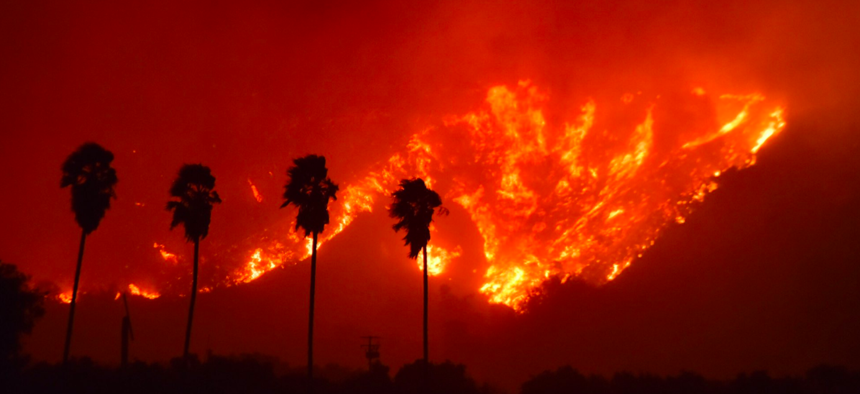Santa Ana Winds Fuel Quickly Moving Fire in Southern California

A quickly moving fire started Monday evening near Santa Paula, California Ventura County Fire Department

Connecting state and local government leaders
After an already difficult year across the West, dangerous fire weather conditions continue in parts of the Golden State.
Strong winds and low humidity have created dangerous fire weather conditions across parts of Southern California this week, especially in Los Angeles County and Ventura County, where a new blaze broke out Monday night near the city of Santa Paula and was threatening populated areas.
The Thomas Fire prompted local authorities to issue mandatory evacuations orders in the Santa Paula area, which is located about 65 miles northwest of downtown Los Angeles. Students at Thomas Aquinas College near Santa Paula were also evacuated.
The brush fire, fueled by Santa Ana winds, started mid evening and quickly grew from 50 acres to 500 acres and then, in less than an hour, to 2,500 acres, according to KTLA-TV. According to a tweet from the Ventura County Fire Department's public information officer, the fire had grown to 5,000 acres by 9:45 p.m. local time Monday.
By 7 a.m. local time Tuesday, Ventura County emergency management officials reported that the blaze had grown to more than 30,000 acres as it moved west toward the city of Ventura. "Due to the intensity of the fire, crews are having trouble making access and there are multiple reports of structures on fire. Fire crews from many different agencies are actively working on the incident. There are 500 fire fighters on scene with additional fire resources enroute," according to the advisory.
The National Weather Service in Los Angeles warned that wind gusts of 50-70 mph were creating very dangerous fire conditions across the region.
"This is exactly what we have prepared for," Ventura County Fire Capt. Stan Ziegler said, according to the Los Angeles Times. "This is not a surprise by any means."
Although December isn’t always associated with high fire risk in Western states, it is a month when Santa Ana winds—which bring strong gusts down out of the mountains toward California’s coast—can kick into high gear. The windy conditions are expected to last through Thursday, meaning that there could be more fires.
The fire burned power transmission lines, cutting electricity to at least 250,000 customers in Ventura and Santa Barbara counties, KTLA reported early Tuesday morning.
There are major concerns over power lines sparking blazes. According to Southern California Public Radio / KPCC:
During the red flag warning, residents might have to wait longer for power to come back on if it goes out.
Under normal conditions, power would automatically cycle back on after a momentary outage. But during a red flag warning, utility workers will keep the power off until the faulty line can be inspected, [Southern California Edison spokesman Brian] Leventhal said.
“In cases where a fault is caused by physical damage to a wire such as a tree falling into the line during high winds, the patrol will find and correct that condition before energizing the circuit,” he said.
2017 has been a difficult year for wildfires across the West but especially in California. In Sonoma County north of San Francisco, the destructive Tubbs fire in the Santa Rosa area burned 4,658 homes and 94 commercial structures in October, according to the Santa Rosa Press Democrat.
Forty-four people died in that wind-fueled fire, including many elderly residents who couldn’t escape in time.
That fire, which burned out of the foothills and into more urbanized areas of Santa Rosa thought to be “unburnable,” has prompted questions about whether fire hazard maps in California need to be rethought.
"With a lot of hazard mapping, once you get into a density of development, it's mapped urban and it's considered unburnable," fire scientist Max Moritz of the University of California's Cooperative Extension, told the Los Angeles Times in October. "From its core, our whole approach to fire behavior modeling, we are not talking about burning in urbanized environments."
This article has been updated with new information about the growth of the Thomas Fire.
RELATED on Route Fifty:
Michael Grass is Executive Editor of Government Executive's Route Fifty and is based in Seattle.

NEXT STORY: New York City Defends Its Community Policing Approach





